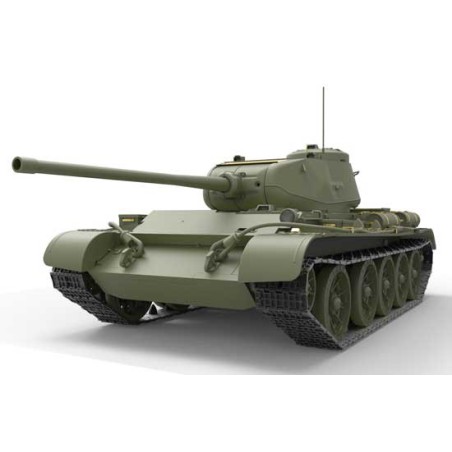HISTORICAL INFORMATION
SOVIET MEDIUM TANK ?-44
Produced: 1944-1947
Number built: 1.823
SPECIFICATIONS
Crew: 4
Weight: 31 t
Length: 6070 mm
Length with gun forward: 7650 mm
Width: 3180 mm
Height: 2410 mm
Base: 3800 mm
Ground clearance: 425 mm
Engine: Model V-44 12-cyl. Diesel 500 hp?Max. road speed: 60 km/h
Max. cross country speed: 25-30 km/h?Max. operational range: 250 km
Suspension type: personal torsion-bar
Specific ground pressure: 0.83 kg/cm²
Gradeability: 30 deg.
Surmounted the wall: 0.73 m
Trench: 2.5 m
Fording: 1.3 m
Armour: 15-120 mm
ARMAMENT
Mark: ZIS-S-53 standard in 1944 (58 rds.)
Caliber: 85 mm
Type of gun: rifled
Sight: telescopic TSh-16
Machine gun: 2 x 7.62-mm DTM
HISTORY
T-44 was created in 1943-1944. Though the T-44 did not see combat in World War II, it was issued to tank brigades for training purposes. It was never shown publicly during military parades and pictures were never shown publicly until the secrecy was dropped. T-44 was being developed in order to create a tank that would have better combat and technical characteristics than the T-34.
SPECIFIC FEATURES
The original intention was to retain the high mobility and speed of a T-34 and to pro the T-44 with heavier armour protection against large-caliber tank guns. This was accomplished by adding thicker armour but reducing the internal volume of the hull. Although the T-44 used many components of the T-34, it had a new hull, and a modified model diesel engine, suspension and transmission.
THE MAIN DIFFERENCES FROM THE T-34-85
T-44’s hull had a simplified construction without fenders. The hull of the T-34-85 had T-shape cross-section while T-44’s hull had a rectangular shape. The height of the t-44’s hull was reduced to 300 mm.
The new V-44 12-cylinder 4-stroke diesel engine, developing 500 hp, was a more powerful version of the T-34's model V-2 with a new planetary manual 5-speed transmission system, filtration system, improved cooling system, horizontally placed water and oil pumps and an improved fuel system which increased its power output. It was the first tank design to feature transverse engine placement, which made it smaller than a standard T-34 and gave the crew more space.
The hull upper front armour (glacis plate 60°) thickness was doubled to 90 mm. Even though it was more heavily armoured, the weight of the T-44 was the same.
The tank's crew did not include a radio operator/machine gunner. This space was used for ammunition stowage area, transferred from the floor of the fighting compartment. As a result were improved working conditions.
The bow machine gun and driver's hatch switched positions on the glacis plate.
One of the machine guns was mounted to fire through a tiny hole in the center of the glacis plate. Because the tank's crew did not include a radio operator/machine gunner, the driver operated this light machine gun.
The T-44 had a compact torsion-bar suspension instead of the T-34's Christie coil springs.































































